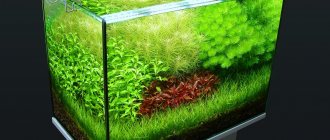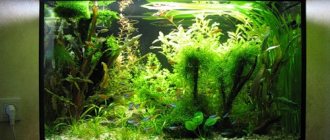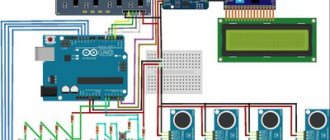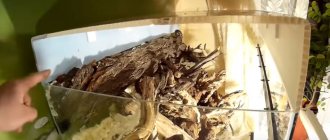Light characteristics
Aquarium plants develop well in different lighting conditions. Some of them need bright light, while some need low light. That is, the choice of lamps depends on what will grow in the aquarium.
Lighting power standards in fluorescent lamp watts:
- 0.1 – 0.2 W/l – used in containers without living plants.
- 0.2 - 0.4 W/l - installed in aquariums with catfish and other nocturnal fish. With such power, the following plants will grow well: Vallisneria, cryptocorynes, mosses.
- 0.4 – 0.5 W/l – used in jars with unpretentious higher plants. At the same time, the greenery grows slowly and stretches upward towards the light.
- 0.5 – 0.8 W/l – with this light you can make a beautiful aquarium. The plants will grow well and their leaves will be brightly colored.
- 0.8 - 1 W/l - such powerful lamps are used only in densely planted herbal gardens with ground cover plants. Such aquariums are called aquascapes, Amanovsky or Dutch.
Recently, with the advent of new technologies in the production of lamps, the illumination in an aquarium is usually calculated in lumens. Standards in watts are outdated. After all, incandescent, fluorescent, LED and halogen lamps with the same electrical power of 50 watts shine with different intensities.
Lighting power standards in lumens:
- Low lighting – up to 30 lm/l.
- Moderate lighting – 30-50 lm/l.
- Preferred illumination is 50-70 lm/l.
- High illumination – 70-100 lm/l.
- 100 lm/l and above - very high illumination.
Watt-lumen table
Let's bring this data together. The watts of the fluorescent lamp are indicated on the left; if you are using another type of lamp, use the watt to lumen conversion table located below in the article.
| Illumination | in watts | in lumens |
| weak | 0,1-0,2 | up to 30 |
| moderate | 0,2-0,4 | 30-50 |
| preferred | 0,4-0,5 | 50-70 |
| high | 0,5-0,8 | 70-100 |
| very high | 0,8-0,1 | above 100 |
The illumination of an aquarium in lumens is arbitrary, since all aquariums have different heights. So for cans with a water column height of 20 cm, 30 lm/l is enough, and if the water column height is 60 cm, then in this case even 50-70 lm/l will not be enough. The brightness of the lighting is influenced by the transparency of the water, as well as the direction of the lighting. A fluorescent lamp will shine into all corners of the aquarium; LED lamps are characterized by a directional flow of lighting.
Based on the above, it turns out that LED lighting sources shine clearly downwards, but fluorescent lamps shine to the sides, up and down. In order for the lighting from fluorescent lamps to reach the bottom of the aquarium, reflectors must be installed in the lid.
Consider all these parameters when choosing lighting and the power of its luminous flux! — The height of the aquarium, the direction of light, the transparency of the water, large plants shading other small ones.
In addition, lighting also depends on the aging of the lamps, the presence or absence of a cover glass, and air temperature. Depending on the lighting power, the issue of supplying carbon dioxide and feeding plants with fertilizers is decided. The fact is that the process of photosynthesis in plants occurs only in light; they consume carbon dioxide and fertilizers and convert it all into tissue. In low light, there is no photosynthesis, meaning plants cannot consume nutrients and carbon dioxide.
If there are a lot of nutrients in the water, then algae, xenococus, flip flop, beard, and endogonium begin to develop in the aquarium. If everything is fine with the lighting, then the plants grow quickly and delight with their beautiful appearance. You can learn about the process of photosynthesis by the presence of oxygen bubbles on the leaves 1-2 hours after turning on the light. But keep in mind that bubbling is observed only with good lighting, carbon dioxide supply and fertilizer application.
Aquarium plants without light
Now, what can grow if the lighting of the aquarium is almost zero. Sometimes they say that somewhere (or at home) plants grow without specialized lamps. That everything is fine and there is no need to spend more. But just by comparing photographs of aquariums where the light is of high quality and where there is no light, everything will immediately become clear to you. This is not the normal existence of plants, since in the light they look completely different.
1 – almost no light – the lamps are not special; the following will grow: Vallisneria, Hornwort, Elodea, Cladophora.
2 – lamps for plants, but too little light, will grow: anubias nana, hygrophila loosestrife, cryptocarinae, ferns.
But just keep in mind, this is what plants that received light and plants that received little light look like.
And at the end, this is what the aquarium looks like under our light. Just launched. You can go to our aquarium channel and there you will find new versions of this aquarium.
Mistakes made by aquarists
Some aquarists install special aquarium lamps above the aquarium with peaks in the blue and red spectrum and at the same time increase daylight hours. Due to such actions, the plants begin to become covered with algae: threadwort, xenococus, Vietnamese, beard. To grow well, freshwater aquarium plants require broad-spectrum lighting with a color temperature of 6,500 to 8,000 Kelvin. Special lamps should only be installed when they are complemented by other light sources.
Daylight hours
The daily routine is 12 hours. During this time, use the maximum illumination intensity. It is necessary to familiarize yourself in detail with the inhabitants of the animal and plant aquarium. It is possible to turn on special light sources at night. Some types of plants wake up at night and need light.
Programmable time relay with socket power on.
Types of lamps for aquarium lighting
Various types of lamps and their variations can be used for lighting. They all have certain advantages and disadvantages.
Incandescent lamps
This type of lighting is only suitable for land turtles. The lamps produce a huge amount of heat, which leads to heating of the water. Algae will definitely appear in aquariums with such lighting.
Halogen lamps
They are slightly better than incandescent lamps, as they are smaller and have higher efficiency. They should not be installed in aquariums with plants.
Fluorescent lamps
This is the most popular lighting source. It is reasonably priced and lasts a long time. In addition, the light output of fluorescent lamps is much higher than that of incandescent lamps. But there are also disadvantages. These include a narrow spectral range, poor permeability into the water column and the fact that they produce scattered light. It is recommended to use such a lighting source with reflectors for 6-12 months. After this period, the lamp is replaced with a new one. The following types of lamps are used in aquarium farming: T8, T5 and in rare cases T4.
T8 are the most popular lamps. They perfectly combine price and quality.
T5 is better quality and more expensive than T8. They provide directional and intense light.
LED lamps, spotlights, strips
Nowadays, stores sell good LED spotlights with a light temperature of 6500K and any number of lumens. They are economical and safe to use. During operation, they heat up only from the radiator side, thanks to which they can be built into the aquarium lid. If there is no cover, they are installed on homemade aluminum profile racks or a railing system. They illuminate the aquarium almost the same as metal halide lamps.
Metal halide lamps, spotlights, panels
This lighting is used in herbalists with any plants, as well as when the aquarium height is 60 cm or more. The lamps are sold at reasonable prices, have a directional luminous flux, good performance (100lm/W), and last 15,000 hours. Their light temperature ranges from 2500K (yellow light) to 20000K (blue light).
Metal halide lamps are small in size and the light reaches the very bottom. Looking at your underwater world, you will see shadows from plants and fish.
The only drawback of metal halide lamps is the inability to integrate them into the cover. They are hung only on racks or pendants at a distance of 30 cm from the water, as they get very hot.
Calculate illumination in lumens! If the lamp does not indicate the luminous flux in lumens, use the watts to lumens conversion table , which you see below.
Types of lamps
There are two types of lamps - closed and open. They differ in their design, since in the first version the lighting fixture is attached to the lid and is made as one element. Open type – the lamp is mounted above the water.
As a rule, closed lamps are made of plastic, and LEDs are used as a lighting element. The main thing is that they effectively illuminate every centimeter of the aquarium.
An open lamp has many advantages:
- It dissipates heat perfectly;
- Creates a natural lighting effect, highlighting fish and plants.
Typically, halogen lamps are used in such designs.
Calculation examples. Aquarium 100 liters.
№1. An average illumination of 50 lm/l is required, a total of 50 lm/l * 100 l = 5000 lm. There are LED lamps on sale with the lumens indicated on the packaging - 10W (800lm), 20W (1600lm). This means that we will need three 20W spotlights, which in total gives 1600lm + 1600lm + 1600lm = 4800lm, which is practically what we need.
№2. Moderate illumination of 35lm/l is required, total 35lm/l * 100l = 3500lm. We select the power and number of fluorescent lamps. It’s a little more complicated here, since with higher power the length of the lamp also increases, because you can’t build a lamp with a length of 895mm into an aquarium with a length of 600mm. But let’s ignore this for now, we only count power and quantity. JBL T8 lamps are on sale - 15W 438mm, 25W 742mm, 30W 895mm, 36W 1200mm and others. Let's say we are satisfied with lamps 742 mm long, 25 W each, according to the conversion table, 25 watts of a fluorescent lamp are equal to 1200 lumens, it is obvious that we will need three lamps 1200 lm + 1200 lm + 1200 lm = 3600 lm.
№3. A high 100lm/l is required, a total of 100lm/l * 100l = 10,000lm. LED lamps with a color temperature of 6500k are on sale - 10W (800lm), 20W (1600lm), 30W (2400lm), 50W (4000lm). This means that we will need 4 30W lamps, which in total gives 2400lm + 2400lm + 2400lm + 2400lm = 9600lm. Or 2 of 50W and 1 of 30W, for a total of 4000 + 4000 + 2400 = 10400lm.











